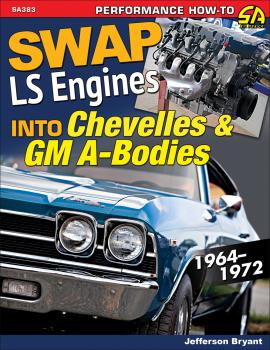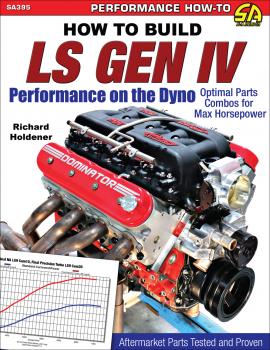Ingram
Все книги издательства IngramFord Big-Block Parts Interchange
Over the course of performance car history, and specifically muscle car history, big-block engines are particularly beloved, and for good reason. Not only are they the essence of what a muscle car is, but before modern technology and stroker engines, they were also the best way to make a lot of horsepower. All of the Detroit manufacturers had their versions of big-block engines, and Ford was no exception. Actually, Ford was somewhat unique in that it had two very different big-block engine designs during the muscle car era.<p>The FE engine was a design pioneered in the late 1950s, primarily as a more powerful replacement for the dated Y-block design because cars were becoming bigger and heavier, and therefore, necessitated more power to move. What started as torquey engines meant to move heavyweight sedans morphed into screaming high-performance mills that won Le Mans and drag racing championships through the 1960s. By the late 1960s, the design was dated, so Ford replaced the FE design with the «385» series, also known as the «Lima» design, which was more similar to the canted-valve Cleveland design being pioneered at the same time. It didn't share the 1960s pedigree of racing success, but the new design was better in almost every way; it exists via Ford motorsports offerings to this day.</p><p>In <i>Ford Big-Block Parts Interchange</i>, Ford expert and historian George Reid covers these engines completely. Interchange and availability for all engine components are covered including cranks, rods, pistons, camshafts, engine blocks, intake and exhaust manifolds, carburetors, distributors, and more. Expanding from the previous edition of <i>High-Performance Ford Parts Interchange</i> that covered both small- and big-block engines in one volume, this book cuts out the small-block information and devotes every page to the MEL, FE and 385 series big-blocks from Ford, which allows for more complete and extensive coverage
Swap LS Engines into Chevelles & GM A-Bodies
The GM LS engine has revolutionized the muscle car and the high-performance V-8 market. It has become a favorite engine to swap into classic cars because it offers a superior combination of horsepower, torque, and responsiveness in a compact package. As such, these modern pushrod V-8 engines are installed in vintage GM muscle cars with relative ease, and that includes Chevelles and other popular GM A-Body cars. In fact, General Motors manufactured about 500,000 Chevelles and A-Body cars between 1968 and 1970 alone.<p>Jefferson Bryant, author of <i>LS Swaps: How To Swap GM LS Engines into Almost Anything</i>, has performed many LS swaps throughout his career, and has transplanted the LS into several A-Body cars. In this comprehensive guide, he provides detailed step-by-step instructions for installing an LS powerplant into a Chevelle, Buick GS, Oldsmobile Cutlass, and Pontiac GTO. To successfully install an LS engine, you need to select or fabricate motor mounts and adapter plates to mount the engine to the chassis. Also, you need to integrate the electronic engine controls and wiring harness to the A-Body car. If you run a fuel-injection system, a new tank or high-pressure fuel pump, fuel lines, and related equipment must be installed. Bryant covers all of these crucial steps and much more. He explains essential procedures, time saving techniques, and solutions to common problems. In addition, he performs a new LT swap into an A-Body car. <p>Swapping an LS engine into an A-Body is made much easier with a comprehensive guidebook such as this, whether you plan on doing it yourself or decide to have a shop do it for you. A huge and thriving aftermarket provides a wide range of suspension, brake, steering, chassis, and other parts that produce functional improvements. Before you tackle your LS Swap project, arm yourself with this vital information to guide you through the process.
How to Build LS Gen IV Performance on the Dyno
The GM LS engine has redefined small-block V-8 performance. It's the standard powerplant in many GM cars and trucks and it has been installed in a variety of muscle cars, hot rods, and specialty cars to become the undisputed sales leader of crate engines. The aftermarket has fully embraced the GM Gen IV LS engine platform offering a massive range of heads, intakes, pistons, rods, crankshafts, exhaust, and other parts. <p>Seasoned journalist and respected author Richard Holdener reveals effective, popular, and powerful equipment packages for the Gen IV LS engine. With this information, you can select the parts to build a powerful and reliable engine by removing the research time and guesswork to buy a performance package of your own. In this book, performance packages for high-performance street, drag race, and other applications are covered. And then the assembled engine packages are dyno tested to verify that the parts produce the desired and targeted performance increases. This comprehensive build-up guide covers intakes, throttle bodies, manifolds, heads and camshafts, headers and exhaust, engine controls, superchargers and turbochargers, and nitrous oxide.<p>With so many parts available from a myriad of aftermarket companies, it's easy to become confused by the choices. This book shows you a solid selection process for assembling a powerful engine package, shows popular packages, and then demonstrates the dyno results of these packages. As such, this is an indispensible resource for anyone building GM LS Gen IV engine.
Ford 429/460 Engines: How to Rebuild
Ford was unique in that it had two very different big-block engine designs during the height of the muscle car era. The original FE engine design was pioneered in the late 1950s, primarily as a more powerful replacement for the dated Y-block design. What began as torquey engines meant to move heavyweight sedans morphed into screaming high-performance mills that won Le Mans and drag racing championships throughout the 1960s. <p>By the late 1960s, the FE design was dated, so Ford replaced it with the 385 series, also known as the Lima design, in displacements of 429 and 460 ci, which was similar to the canted-valve Cleveland design being pioneered at the same time. It didn’t share the FE pedigree of racing success, mostly due to timing, but the new design was better in almost every way; it exists via Ford Motorsports’ offerings to this day. Beginning in 1971, the 429 found its way between the fenders of Mustangs and Torinos in high-compression 4-barrel versions called the Cobra Jet and Super Cobra Jet, and they were some of the most powerful passenger car engines Ford had ever built. If the muscle car era had not died out shortly after the release of these powerful engines, without a doubt the 429 performance variants would be ranked with the legendary big-blocks of all time. <p>In this <i>revised edition</i> of <i>How to Rebuild Big-Block Ford Engines</i>, now titled <i>Ford 429/460 Engines: How to Rebuild</i>, Ford expert Charles Morris covers all the procedures, processes, and techniques for rebuilding your 385 Series big-block. Step-by-step text provides details for determining whether your engine actually needs a rebuild, preparation and removal, disassembly, inspection, cleaning, machining and parts selection, reassembly, start-up, and tuning. Also included is a chapter in building the special Boss 429 engines, as well as a bonus chapter on the Ford 351 Cleveland, Ford’s little brother to the big-block.
Media Blasting & Metal Preparation
In Media Blasting & Metal Preparation: A Complete Guide, restoration expert and veteran author Matt Joseph gives you all the tools you need to expertly prepare your car, motorcycle, or anything made of metal for the next stages of restoration. With this handy new guide, Joseph provides all you need to know for a successful and long-lasting restoration.
Oldsmobile V-8 Engines
Author Bill Trovato is recognized for being one of the most successful Oldsmobile engine experts, and he openly shares all of his proven tricks, tips, and techniques for this venerable power plant. In this revised edition of Oldsmobile V-8 Engines: How to Build Max Performance, he provides additional information for extracting the best performance.
Chevy Big Blocks
Master engine builder David Vizard takes big-block Chevy engine building to the next level and shows how to build these extreme high-performance engines without breaking the bank. This book goes well beyond the basic performance techniques and delves into exceptional detail on each component group of the engine.
How to Repair Automotive Air-Conditioning & Heating Systems
Technical instructor and HVAC expert Jerry Clemons completely covers both air-conditioning as well as heating systems , so you can save money repairing your own vehicle.Covered is a history of HVAC systems, airflow throughout the system, the principles of refrigerant, diagnosis of common faults in older systems, testing procedures, and finally repair and, in the case of air conditioning, recharging your system. Also included is proper evacuation and disposal of any residual refrigerant in the system. Components such as compressors, condensers, evaporators and heater cores, pressure switches and climate control electrics and switches are also covered. Finally, for people with older cars, converting from the no-longer-available R-12 to R134a is detailed. Automotive climate controls are a complex system and are difficult to repair without proper instruction. Whether you are trying to get your old classic back to its original form or are just looking to save on expensive repairs, author Jerry Clemons and this book provide the knowledge you will need to get your car back on the road and cruising in comfort.
Steve Magnante's 1001 Mustang Facts
Whether you're an avid fan of all Mustangs, a trivia buff who wants to stump your friends, or have a particular affinity for a particular era of Mustangs, this book is an informative and entertaining collection of facts from one of the industry's most beloved and respected sources.
Weld Like a Pro
Whether you're new to welding or a veteran welder looking to work with special materials or involved in a special project, you will find indispensible information within the pages of this book. Now you can confidently weld with steel, cast iron, aluminum, anodized steel, titanium, magnesium, and other specialty metals.









